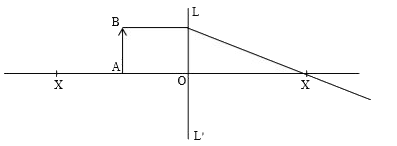The orbital diagram in which the Aufbau principle is violated is




The correct Answer is:B
To solve the question regarding which orbital diagram violates the Aufbau principle, we need to understand the principle itself and analyze the options provided. Here’s a step-by-step breakdown of the solution:
Step 1: Understand the Aufbau Principle
The Aufbau principle states that electrons fill atomic orbitals in order of increasing energy levels. This means that lower energy orbitals are filled before higher energy orbitals.
Step 2: Identify the Energy Levels
In the context of the question, we need to consider the 2s and 2p orbitals:
- The 2s orbital (n=2, l=0) has a lower energy than the 2p orbital (n=2, l=1).
- According to the Aufbau principle, the 2s orbital should be filled before the 2p orbital.
Step 3: Analyze the Options
Without specific diagrams provided, we can infer the following:
- If an orbital diagram shows that the 2p orbital is being filled before the 2s orbital, it violates the Aufbau principle.
- We need to check each option to see if any of them show the 2p orbital being filled before the 2s orbital.
Step 4: Determine the Correct Answer
From the analysis:
- If option (b) shows the 2p orbital starting to fill or pairing before the 2s orbital is completely filled, then this option violates the Aufbau principle.
- Options (a) and (c) fill the 2s orbital before the 2p orbital, adhering to the Aufbau principle.
Conclusion
The orbital diagram in which the Aufbau principle is violated is option (b).
---
The Aufbau principle states that electrons fill atomic orbitals in order of increasing energy levels. This means that lower energy orbitals are filled before higher energy orbitals.
In the context of the question, we need to consider the 2s and 2p orbitals:
- The 2s orbital (n=2, l=0) has a lower energy than the 2p orbital (n=2, l=1).
- According to the Aufbau principle, the 2s orbital should be filled before the 2p orbital.
Without specific diagrams provided, we can infer the following:
- If an orbital diagram shows that the 2p orbital is being filled before the 2s orbital, it violates the Aufbau principle.
- We need to check each option to see if any of them show the 2p orbital being filled before the 2s orbital.
From the analysis:
- If option (b) shows the 2p orbital starting to fill or pairing before the 2s orbital is completely filled, then this option violates the Aufbau principle.
- Options (a) and (c) fill the 2s orbital before the 2p orbital, adhering to the Aufbau principle.
The orbital diagram in which the Aufbau principle is violated is option (b).
Topper's Solved these Questions
- ATOMIC STRUCTUREBOOK - CENGAGE CHEMISTRY ENGLISHCHAPTER - ATOMIC STRUCTUREEXERCISE - Archives Integer
2 Videos
- ATOMIC STRUCTUREBOOK - CENGAGE CHEMISTRY ENGLISHCHAPTER - ATOMIC STRUCTUREEXERCISE - Archives Fill In The Balnks
8 Videos
- ATOMIC STRUCTUREBOOK - CENGAGE CHEMISTRY ENGLISHCHAPTER - ATOMIC STRUCTUREEXERCISE - Archives Multiple Correct
7 Videos
- APPENDIX - INORGANIC VOLUME 1BOOK - CENGAGE CHEMISTRY ENGLISHCHAPTER - APPENDIX - INORGANIC VOLUME 1EXERCISE - chapter-7 Single correct answer
1 Videos
- CHEMICAL BONDING AND MOLECULAR STRUCTUREBOOK - CENGAGE CHEMISTRY ENGLISHCHAPTER - CHEMICAL BONDING AND MOLECULAR STRUCTUREEXERCISE - Archives Subjective
15 Videos
Similar Questions
the orbital diagram in which aufbau principal is violated is :
View SolutionThe orbital diagram in which Hund's rule and Aufbau principle is violated is
View SolutionThe orbital diagram in which both Pauli's exclusion principle and Hund's rule are violated , is :
View SolutionThe orbital diagram in which both the Pauli's exlusion principle and Hund's rule violated is
View SolutionThe orbital diagram in which both the pauli's exclusion principal and Hund's rule are violated is :
View SolutionThe orbital diagram in which both the pauli's exclusion principal and Hund's rule are violated is :
View SolutionThe orbital diagram in which both the pauli's exclusion principal and Hund's rule are violated is :
View Solutionthe current statement on the Aufbau principle is that
View Solution
Name a device in which this principle is used.
View SolutionName the law on which this principle is based.
View Solution
